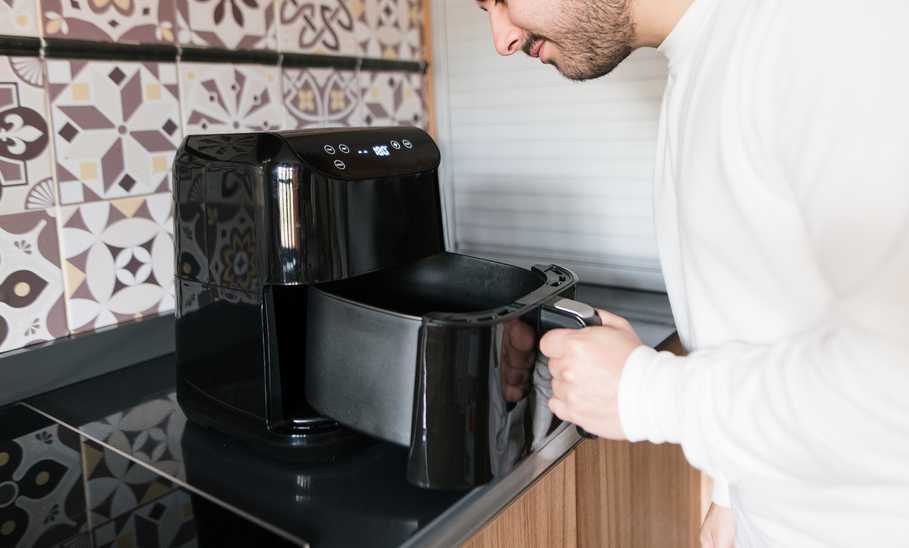How Do Air Fryers Work? A Complete Guide to a Kitchen’s Most Useful Appliance

Our evaluations and opinions are not influenced by our advertising relationships, but we may earn a commission from our partners’ links. This content is created by TIME Stamped, under TIME’s direction and produced in accordance with TIME’s editorial guidelines and overseen by TIME’s editorial staff. Learn more about it.
Having spent the greater portion of my 20s working in the service industry in a variety of kitchens and restaurants, I’ve experienced my fair share of appliances and kitchen equipment. I also do a great deal of cooking at home, which can easily mean an endless stream of cleaning pots, pans, baking sheets, and casserole dishes. That’s all in addition to buying tons of oil for frying on the stove top, or even more when using a deep fryer. Let’s not forget about disposing of the used oil and all of the cleanup involved with traditional frying.
Something clicked one day when I was trying to fry batches of french fries in my countertop deep fryer while also attempting to bake crispy tofu in my traditional oven one chilly December afternoon. It was too cold to have the windows open, so the fryer oil smell was overwhelming and the tofu spent 45 minutes getting as close to crispy as I was willing to wait for.
Skip ahead to a year later, and I was running two air fryers—one with french fries and one with crispy buffalo cauliflower, both with multiple batches—and I used probably 3 tablespoons of oil total.
Making the change from traditional oven and deep frying can seem like an herculean task, and a big portion of the hesitation are the unknowns. Here are the top questions and answers that may be holding you back from buying, what I consider, my most prized appliance in my kitchen.
An air fryer can best be described as a multipurpose, compact, countertop oven. With some practice and the ideal model air fryer, it can take the place of a toaster and toaster oven (and yes, there’s a difference), a deep fryer, and in some capacity, even a standard kitchen or convection oven.
Air fryers work on a similar principle as a standard oven in terms of cooking your food by surrounding it with heat in a confined space. The main differences being the size, temperature, and heat source. Air fryers are small countertop appliances that can fit in right next to your espresso machines (with some exceptions). When it comes to the temperature, most air fryers top out at 400°F. The means by which the heat is dispersed depends on the source of the heating element. Is it on the top rather than the sides and/or bottom? Also, one or more fans blow inside the air fryer (like a convection oven) which forces heat directly onto the surface of the food. That last feature is what allows the air fryer to “fry” foods.
Lynda Musante, Senior Product Manager for Hamilton Beach Brands, explains that “air frying is thought to be a healthier way to cook as little or no added oil is needed to achieve a crisp finish/texture on foods.” This means you can make delicious and crispy homemade food without the extra calories from oil. The way they operate also cuts down on fat (if this is a concern): Air fryers hold foods like chicken wings and cuts of meat above the surface of the machine allowing air flow. This also allows a good portion of extra grease and fat to cook off and drip down to the bottom of the air fryer.
I, for one, will own up as somebody who was skeptical about the end product from an air fryer vs a deep fryer or traditional oven, until I purchased my first countertop air fryer. It was a simple basket-style model and big enough to fit about one head of cauliflower. I made french fries for my test drive, and I was convinced. They were crispy, but still retained moisture on the inside. After a quick toss in a bowl with a pinch of sea salt, I had made fresh cut fries in about 18 minutes. There’s really no limitation when it comes to the flavor, texture, and quality of your favorite recipes.
Air fryers are great for main dishes like chicken wings, legs, drumsticks, thighs, and some models can even handle a whole small chicken or hen. You can also cook hamburgers, steaks, pork tenderloin, fish, tofu, vegetables, and pretty much anything you could bake in the oven or fry in a deep fryer (with some exceptions).
One of the best surprises I found while testing out different foods in my air fryer was the way I could replace other appliances like a toaster or toaster oven. You can reheat leftover pizza, bake frozen nuggets or other freezer treats, and even toast up bread.
Sometimes you need something that is easy, doesn’t take much time, and require you to heat the whole house up with your traditional oven, but is still a delicious, home cooked meal. I can’t picture my kitchen without my air fryer(s) now.
here are some recommendations:
![[object Object] [object Object]](https://m.media-amazon.com/images/I/41Zn5GxEKxL.*SL500*.jpg)
![[object Object] [object Object]](https://m.media-amazon.com/images/I/51jCxzgxYwL._*AC_SX300_SY300_QL70_FMwebp*.jpg)

Choosing the air fryer that best fits your kitchen, lifestyle, and cooking needs really comes down to a few things.
After I got hooked with my smaller basket-style model, I upgraded to a similar style air fryer, but with a larger basket (I went from a 1 gallon size to a 2 gallon size). These are great for general use and ideal for frying.
There are also side-by-side basket models, so you can cook two different foods at once. I find these ideal for when you want to cook a main dish and sides, but they require different temperatures or are best separated.
My personal favorite style are the rack-style air fryers. These have 2-3 racks which can be used together or as different size/heat exposure options. You can set your fries on the top rack, as close as possible to the heating element and fan, or you can set some bread on the bottom to make yourself toast. These models tend to come with a basket and sometimes attachments like a rotisserie.
Aside from power consumption concerns (which don’t have too much variation), you’ll want to select an air fryer that has an adequate, yet reasonable, wattage. This will ensure that your air fryer can get up to temperature quickly and stay there while your food is getting crispy and delicious, without causing any electrical issues. Air fryers typically range anywhere from 800 to 2,000 watts. Without getting into the weeds with amps vs your home’s electrical voltage (which is typically 120 volts in most homes), and how that affects the performance of your air fryer, I’ve found that the best range falls between 1300 and 1700 watts. This will avoid tripping a circuit breaker if you have multiple appliances in the same outlet (a lesson learned by having a powerful microwave and toaster in the same plug, causing the circuit breaker to flip and resulting in a tedious trip to the panel to reset everything).
Air fryers stand up to the hype and more. Deep fryers use a ton of oil, while air fryers only require a spray or light toss in your oil of choice to get a crispy result. I also find that deep fryers tend to leave an oil smell that can linger in your house for some time, even with the windows open. When I use my air fryer, while there is a delicious smell that circulates through the kitchen, it disperses much quicker. Deep fryers also require you to wait after every batch, so the oil can come back up to temperature, while air fryers can go from batch to batch in roughly the same amount of time. The only challenge I’ve encountered using my air fryer is trying to replicate foods like beer-battered onion rings . I have found some delicious and effective workarounds to accomplish the crispy, breaded exterior. It takes some practice, but is well worth it.
The obvious difference between an air fryer and a traditional oven is the size. Air fryers are smaller, which is great for counter space, but limiting in terms of how big of a dish you can prepare. Traditional ovens take much longer to get up to temperature, however they do hold their temperature a bit better when opened for flipping/tossing your foods. Traditional ovens have higher temperature settings that can go up to 575°F, sometimes higher. Air fryers tend to top out at 400°F, which is usually more than enough heat for most types of baking, frying, and cooking. Air fryers also cook much faster due to the fan and heating element combination, which allows your air fryer to operate much like a convection oven.
Most air fryers have non-stick drip trays, baskets, and interiors. Once the air fryer is cooled off, you can just use a non-stick safe sponge with some dish soap and water to clean your air fryer. The models with racks are mostly the same, and the racks tend to be dishwasher safe. Just be sure to keep your air fryer clean by wiping it down after every use. It doesn’t take too long and will save you from having to scrub a bit heavier if you miss a wash or two.
It’s a guideline for how to adjust cooking instructions for your recipes. It simply means you cut the temperature by 10% and the cooking time by 20%.
Due to their compact size, air fryers have a much lower energy consumption than a traditional oven. This makes them ideal for smaller, quick meals as opposed to using a traditional oven.
Please consult your air fryer’s owner’s manual on guidelines regarding whether or not foil should be used in your air fryer. Personally, I have safely used foil in my air fryer as long as I follow three simple guidelines. Avoid allowing the foil to come into direct contact with the heating element, ensure it's properly secured to prevent it from blowing around the basket, and steer clear of acidic ingredients, as they can lead to the foil transferring onto the food.
While it seems like pretty much anything can be adapted to be made in an air fryer, I found that Lynda Musante summed up the limits of air fryers best: “[the food] group that’s an exception to this though is bakery goods like breads or biscuits which rise while baking. These foods typically do better in an oven as the powerful air flow in an air fryer may cause the top of your biscuits to cook and brown very quickly which limits the interior from rising and expanding. This can result in a very doughy interior.”
A small amount of oil is required to achieve a crispy exterior for your foods. Some foods require more than others (like an extra spray on your fries, but not on your chicken wings), and with some trial and error, you will get the hang of it.
An inventor in the Netherlands named Fred van der Weij invented the air fryer. He was on a mission to find a way to make a crispy french fry without having to use a traditional deep fryer.
It is safe to cook raw meat in the air fryer as long as it is completely defrosted and monitored. Just be sure to follow food safety guidelines regarding internal temperature for whatever meat you are air frying.
Acrylamide is a potentially harmful chemical compound that can form naturally on certain foods during the cooking process. Specifically starchy root vegetables like potatoes and beets can cause this white, odorless, and crystalline compound to form. You can reduce the amount of acrylamide from forming by soaking your pre-cut veggies in filtered water for 15 or more minutes before cooking.
On average, an air fryer uses about 3-5 kilowatt hours of electricity per hour of use. By comparison, this is roughly less than half of the energy consumption of a traditional oven.
The information presented here is created by TIME Stamped and overseen by TIME editorial staff. To learn more, see our About Us page.



